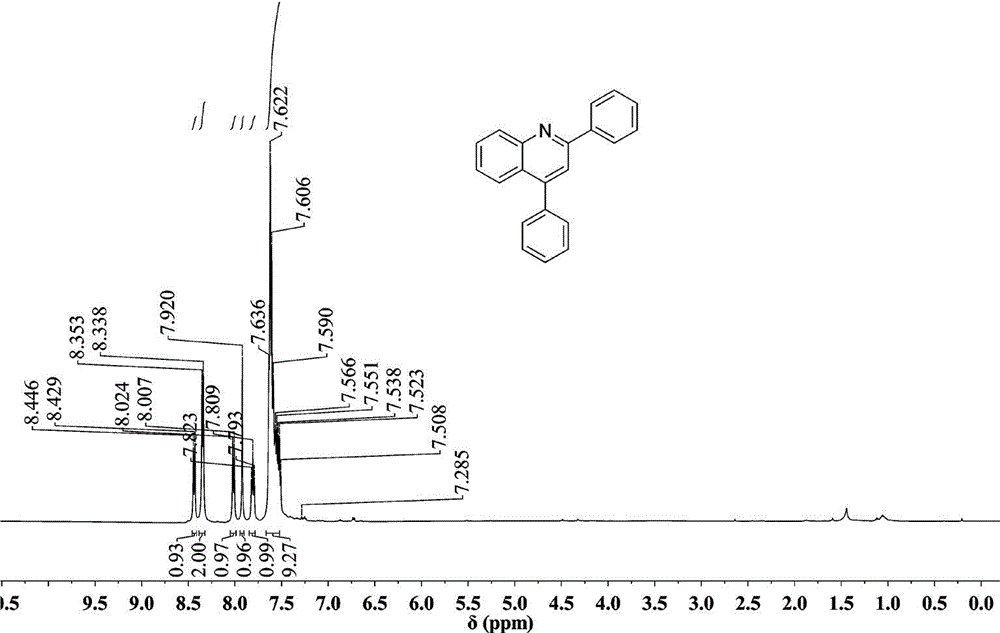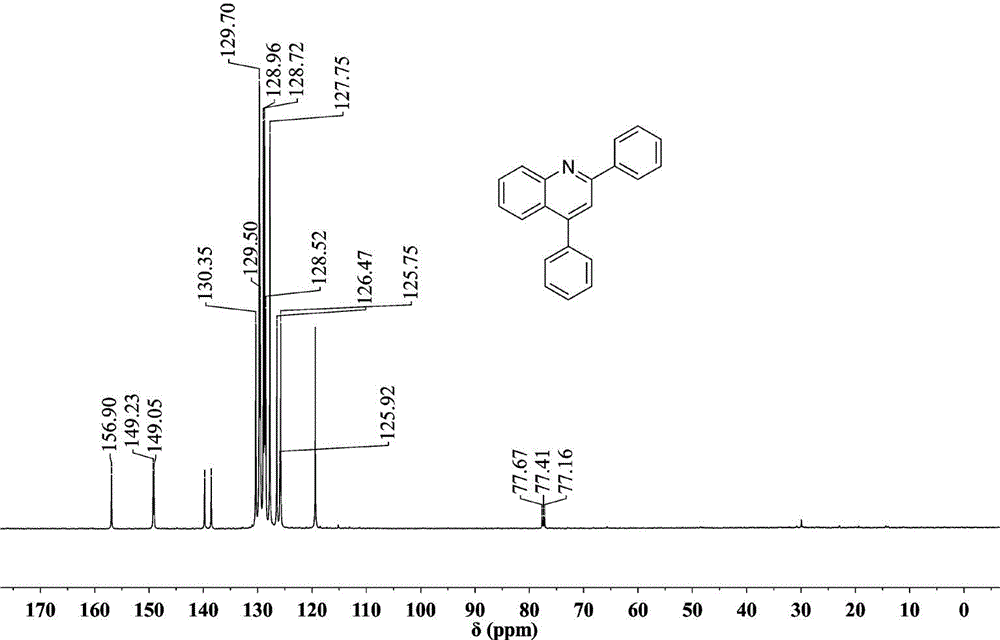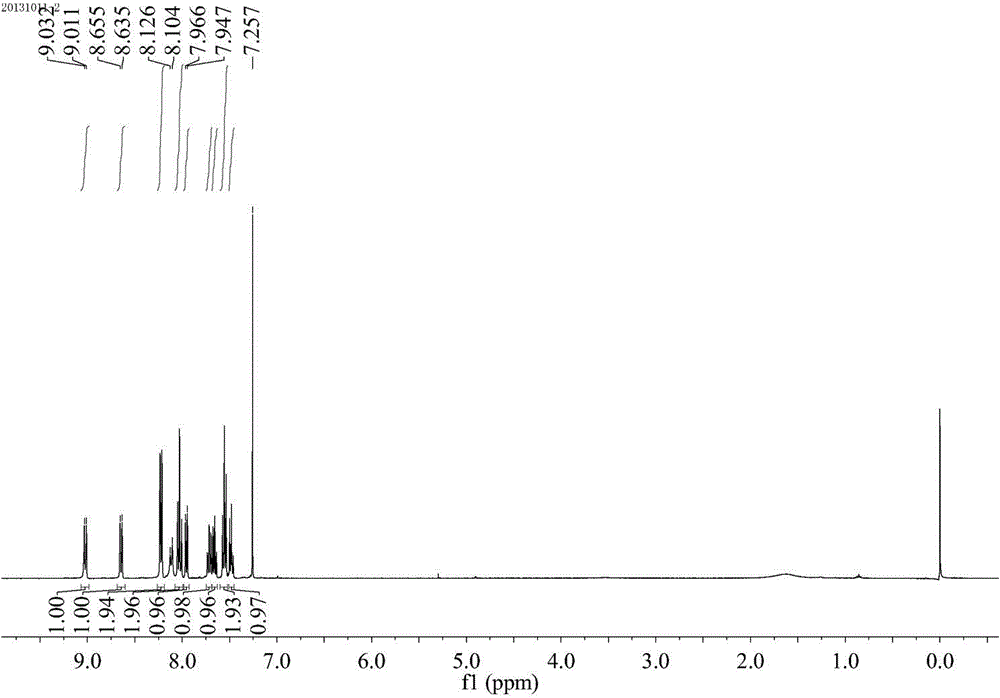A method for efficiently synthesizing quinoline derivatives
A derivative and quinoline technology, applied in the field of quinoline derivatives, can solve the problems of limited quinoline derivatives, high reaction temperature, harsh reaction conditions, etc., and achieve the effects of easy separation and purification, single product, and simple operation
- Summary
- Abstract
- Description
- Claims
- Application Information
AI Technical Summary
Problems solved by technology
Method used
Image
Examples
Embodiment 1
[0027] Preparation of 2,4-Diphenylquinoline: Add 0.5 mmol (46.5 mg) of aniline, 0.005 mmol (1.29 mg) of AgOTf, 0.5 mmol (104 mg) of 1,3-diphenylpropenone, and toluene into the reaction vessel. 2mL. At 110 o C was reacted in an oil bath for 10 hours, cooled to room temperature, the product was extracted with ethyl acetate, and concentrated under reduced pressure. The product was purified by column chromatography to obtain a white solid product with a yield of 96%. 1 HNMR(500MHz, CDCl 3 )ppm:8.43(d, J =8.0Hz,1H),8.34(d, J =8.0Hz,2H),8.00(d, J =8.5Hz,1H),7.92(s,1H),7.80(t,1H),7.51-7.64(m,9H); 13 CNMR(500MHz, CDCl 3 ): 156.90,149.23,149.05,139.77,138.56,130.35,129.70,129.60,129.50,128.96,128.72,128.52,127.75,126.47,125.92,125.75,119.39; HRMS(EI)Calcd.forC 21 H 15 N:[M + ],281.1207; Found:281.1204.
Embodiment 2
[0029] Preparation of 4-phenylquinoline: Add 0.5 mmol (46.5 mg) of aniline, 0.005 mmol (1.29 mg) of AgOTf catalyst, 0.5 mmol (66 mg) of 3-phenyl acrolein, and 2 mL of toluene into the reaction vessel. At 110 o C was reacted in an oil bath for 10 hours, cooled to room temperature, the product was extracted with ethyl acetate, and concentrated under reduced pressure. The product was purified by column chromatography to obtain a white solid product with a yield of 90%.
Embodiment 3
[0031] Preparation of 4-phenyl-2-p-tolylquinoline: Add 0.5mmol (46.5mg) of aniline, AgOTf 0.005mmol (1.29mg), 3-phenyl-1-p-tolyl-?? Propylene ketone 0.5mmol (11.1mg), toluene 2mL. At 100 o C was reacted in an oil bath for 7 hours, cooled to room temperature, the product was extracted with ethyl acetate, and concentrated under reduced pressure. The product was purified by column chromatography to obtain a white solid product with a yield of 89%. 1 HNMR(500MHz, CDCl 3 )ppm:8.36(d, J =8.0Hz,1H),8.25(d, J =8.0Hz,2H),7.95-7.93(d, J =8.0Hz,1H),7.85(s,1H),7.81-7.74(m,1H),7.61-7.52(m,6H),7.38-7.36(d, J =8.0Hz,2H),2.46(s,3H); 13 CNMR(500MHz, CDCl 3 ): 156.9, 149.2, 148.6, 139.4, 138.4, 136.7, 120.2, 129.6, 129.5, 128.5, 128.2, 127.4, 126.1, 125.6, 125.5, 119.1, 21.5; HRMS(EI)Calcd.forC 22 H 17 N:[M + ],295.1369;Found:295.1365.
PUM
 Login to View More
Login to View More Abstract
Description
Claims
Application Information
 Login to View More
Login to View More - R&D
- Intellectual Property
- Life Sciences
- Materials
- Tech Scout
- Unparalleled Data Quality
- Higher Quality Content
- 60% Fewer Hallucinations
Browse by: Latest US Patents, China's latest patents, Technical Efficacy Thesaurus, Application Domain, Technology Topic, Popular Technical Reports.
© 2025 PatSnap. All rights reserved.Legal|Privacy policy|Modern Slavery Act Transparency Statement|Sitemap|About US| Contact US: help@patsnap.com



